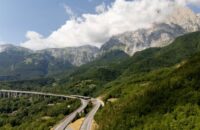During the coldest months of the year, we cover ourselves more to protect ourselves from low temperatures. Our car also needs more protection, because cold weather multiplies the risk factors that threaten the efficiency of our car. In winter we risk not only technical failures, but also safety-related problems. Proper maintenance at this time of year is indispensable.
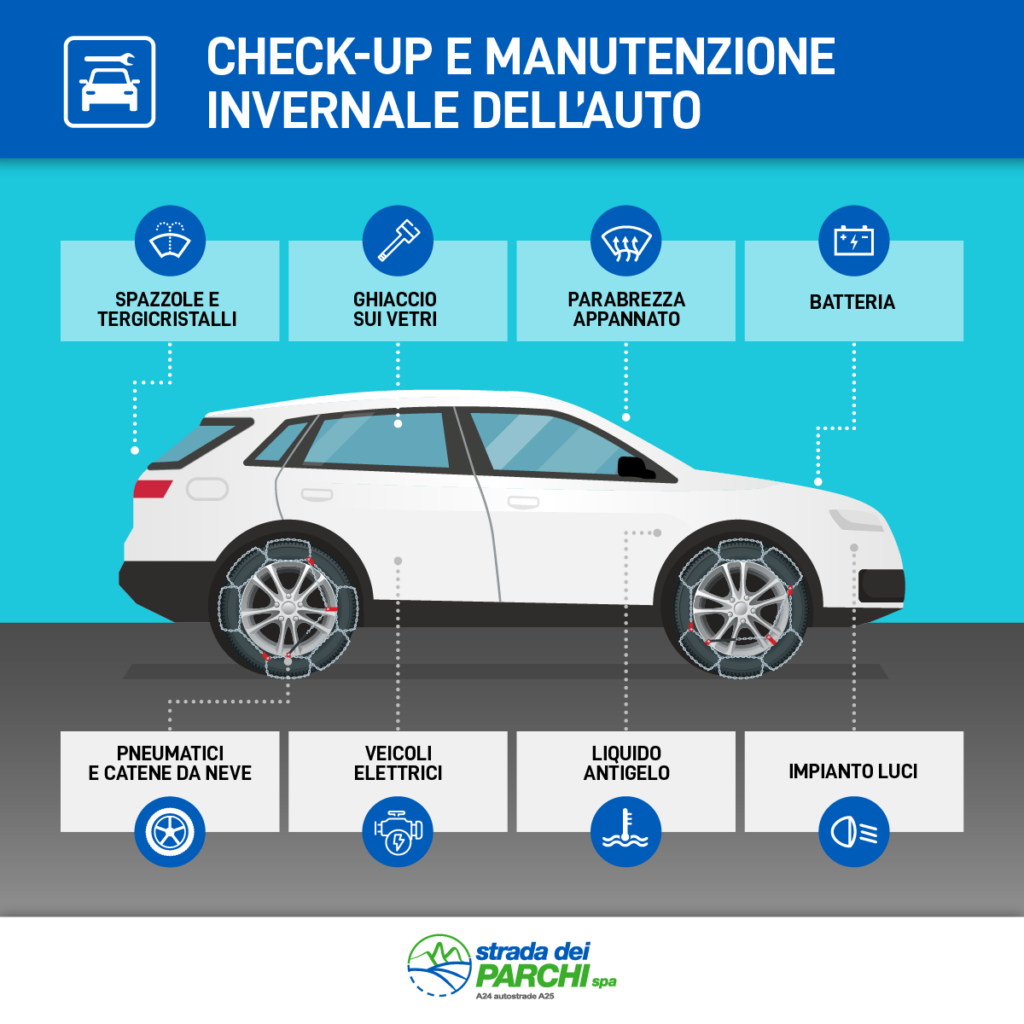
Here are some practical tips for driving with peace of mind without fearing unforeseen events:
Tires and snow chains
As a reminder, on the A24 and A25 highways, from November 15, 2023, until April 15, 2024, there is a requirement for winter tires or snow chains on the vehicle. The regulations also provide for the possibility of fitting snow tires one month earlier, on October 15, and taking them off one month after the end of the obligation, that is, on May 15.
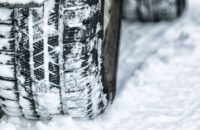 Winter tires must have the initials M+S(Mud and Snow) and the symbol of a mountain with a snowflake. Exempt from the requirement are those who fit approved 4-season tires, on which the M+S marking must always be present. Drivers of vehicles without these equipment on the highway risk fines of 80 to 318 euros, as well as vehicle immobilisation until the tires are in order.
Winter tires must have the initials M+S(Mud and Snow) and the symbol of a mountain with a snowflake. Exempt from the requirement are those who fit approved 4-season tires, on which the M+S marking must always be present. Drivers of vehicles without these equipment on the highway risk fines of 80 to 318 euros, as well as vehicle immobilisation until the tires are in order.
It is important to remember that thermal tires provide increased safety not only in snowfall or on ice, but also in rain. In fact, the special tread of winter tires provides significantly more grip than other types on snow, slush and ice.
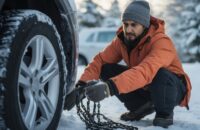 To ensure proper grip, it is important to check that the tread thickness of our winter tires is still adequate. The Highway Code prescribes a minimum tread thickness of 1.6 millimeters for both summer and winter tires. For winter tires, experts recommend a minimum thickness of four millimeters.
To ensure proper grip, it is important to check that the tread thickness of our winter tires is still adequate. The Highway Code prescribes a minimum tread thickness of 1.6 millimeters for both summer and winter tires. For winter tires, experts recommend a minimum thickness of four millimeters.
Quality snow chains provide optimal grip on snow and ice and good driving characteristics, as well as ease of installation and removal. Before hitting the road, we recommend practicing fitting them at home so that you are not caught unprepared in case of an emergency. When buying snow chains, it is important to make sure they are suitable for the size of our tires.
Battery
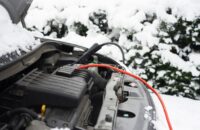 Exposed to the cold of night, a battery, especially an old one, can lose its charge; therefore, it is important to check its health. Therefore, remember to take the car to the garage to perform a charge test. An alternative is to keep a battery charger in the garage or trunk: simply plugging it into a regular outlet will bring the battery back to life in a few hours, even at low temperatures. The battery charger also allows for diagnostics, which can detect whether the battery needs to be replaced because it is too old.
Exposed to the cold of night, a battery, especially an old one, can lose its charge; therefore, it is important to check its health. Therefore, remember to take the car to the garage to perform a charge test. An alternative is to keep a battery charger in the garage or trunk: simply plugging it into a regular outlet will bring the battery back to life in a few hours, even at low temperatures. The battery charger also allows for diagnostics, which can detect whether the battery needs to be replaced because it is too old.
Antifreeze products
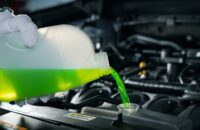 If for many of us a warm beverage is a panacea for enduring the rigors of winter, our car should not lack the products that prevent the engine coolant and windshield wiper fluid from freezing.
If for many of us a warm beverage is a panacea for enduring the rigors of winter, our car should not lack the products that prevent the engine coolant and windshield wiper fluid from freezing.
To avoid risking engine damage, when we add water to our radiator, it is necessary to add a sufficient amount of antifreeze fluid, between 40 and 50 percent of the engine coolant.
To prevent the windshield wiper fluid from freezing, impairing road visibility, it should be mixed with enough antifreeze to prevent clogging of the lines or nozzles.
Lights
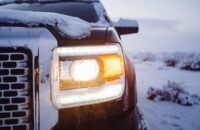 With darkness already arriving in the early afternoon hours, the proper functioning of lights (headlights, turn signals, fog lamps) becomes one of the fundamental principals of safe winter driving.
With darkness already arriving in the early afternoon hours, the proper functioning of lights (headlights, turn signals, fog lamps) becomes one of the fundamental principals of safe winter driving.
We do not think that the lighting system has the one and only purpose of allowing us better vision because, just as it is important to see, so is it important to be seen. In rain or fog or during a snowstorm it becomes an absolute imperative.
We can do a rudimentary test of the lighting system ourselves by observing all the indicators and the front and rear lights of our car reflected on a large window. In any case, in order to avoid dazzling other road users, remember to carry out a periodic professional test of the lights at a trusted workshop to make sure that all the lights in our car are optimally adjusted and oriented.
Ice on the glass
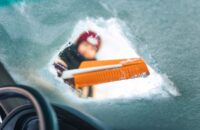 The best solution for removing ice on glass is to use antifreeze sprays, which are specially designed to deal with these situations. Alternatively, a plastic scraper can be used. Metal models, on the other hand, should be avoided, as they may cause damage to the surface of the glass.
The best solution for removing ice on glass is to use antifreeze sprays, which are specially designed to deal with these situations. Alternatively, a plastic scraper can be used. Metal models, on the other hand, should be avoided, as they may cause damage to the surface of the glass.
In addition to a dirty windshield, a fogged windshield can also impair visibility, especially in winter, when the temperature difference between the interior and exterior of the vehicle promotes moisture condensation on the windows.
Tarnished windshield
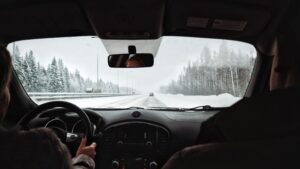 The main cause of windshield fogging is high humidity in the passenger compartment that comes into contact with a cold surface such as glass, generating the dreaded “condensation.” To reduce the risks, during the car’s winter check-up, the passenger compartment air filter should be replaced and the window and sunroof seals should be checked.
The main cause of windshield fogging is high humidity in the passenger compartment that comes into contact with a cold surface such as glass, generating the dreaded “condensation.” To reduce the risks, during the car’s winter check-up, the passenger compartment air filter should be replaced and the window and sunroof seals should be checked.
In case of sudden fogging while driving, the air conditioner, in which the dryer is integrated, can quickly solve the problem. In vehicles without an air conditioner, the air vent that feeds cold air from outside, if oriented toward the windshield, can help. We also recommend keeping a soft, nonabrasive cloth in the glove compartment of the dashboard for emergencies.
Wiper Blades
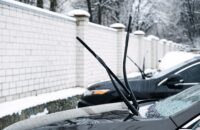 One of the most underestimated and least considered elements in the winter car check-up, or more generally in routine checks, are precisely the windshield wiper blades.
One of the most underestimated and least considered elements in the winter car check-up, or more generally in routine checks, are precisely the windshield wiper blades.
Yet a simple rain shower is enough to make us realize what a fundamental function and role they play in safe driving. That is why they should be checked regularly, about every 6 months. For more scrupulousness one should touch the rubbers by hand, if they are hard and crystallized they will need to be replaced.
Electric vehicles
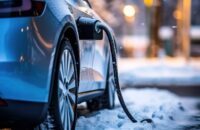 Electric cars, like gasoline- or diesel-powered vehicles, also go through a drop in performance when exposed to particularly cold temperatures. The range of electric cars in winter can be subject to loss because the battery has to generate much more heat, both to bring and maintain the powertrain at optimal operating temperatures and to heat the passenger compartment.
Electric cars, like gasoline- or diesel-powered vehicles, also go through a drop in performance when exposed to particularly cold temperatures. The range of electric cars in winter can be subject to loss because the battery has to generate much more heat, both to bring and maintain the powertrain at optimal operating temperatures and to heat the passenger compartment.
To avoid the risk of frost damage to the battery, let’s remember to always recharge it before it drops below 20% charge. We try to keep the vehicle sheltered from the coldest weather by parking it indoors or covering it with a thermal blanket. Before leaving, let’s study the optimal route to the destination, including possible stops at the charging stations.
As a reminder, on the A24 freeway there are 6 fast and ultrafast charging stations, up to 300 kW and with three types of sockets, at the Tiburtina Sud Service Area on the Urban Penetration Section in Rome, in the direction of L’Aquila/Teramo/A25, open h24. On the A25 highway, there are 22 kW type 2 dual socket charging stations at the Montevelino Nord and Montevelino Sud AdS, near the Magliano de’ Marsi exit, and at the Brecciarola Nord and Brecciarola Sud AdS, between the Manoppello and Chieti/Pescara exits.





